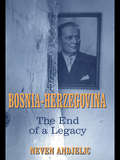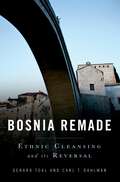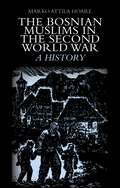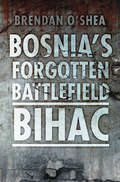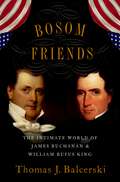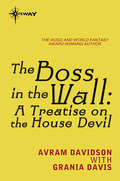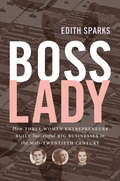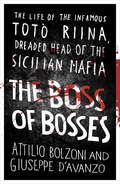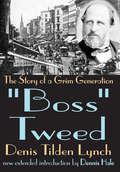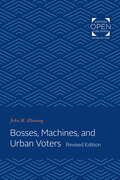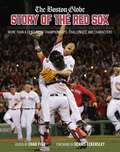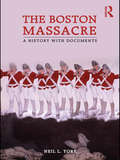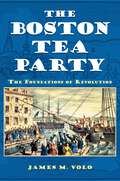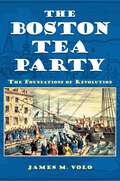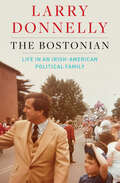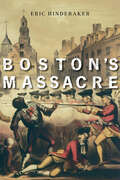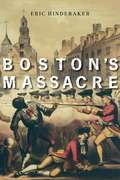- Table View
- List View
Bosnia-Herzegovina: The End of a Legacy
by Dr Neven Andjelic Neven AndjelicWhen the war in Bosnia-Herzegovina broke out a baffled world sought explanations from a range of experts who offered a variety of reasons for the conflict. The author of this study takes Bosnian affairs seriously and in so doing makes it much easier to grasp why the war occurred.
Bosnia-Herzegovina: The Vance/Owen Peace Plan
by David Anthony Llewellyn OwenIn 1992 David Owen was appointed the EU Co-Chairman of the International Conference on the Former Yugoslavia, working alongside the UN’s Co-Chairman, Cyrus Vance. The papers collected here provide fascinating primary source material and an insider’s account of the intense international political activity at that time, which culminated in the Vance-Owen Peace Plan (VOPP). At a time when the international community is looking again at whether and how the Dayton Accords and the 1995 division into two entities should be adjusted in Bosnia-Herzegovina, Owen highlights elements of the VOPP which are of continuing relevance and which can guide political debate and decisions in 2012 and thereafter. Sadly, Bosnia-Herzegovina is still deeply divided, a direct consequence of not imposing the VOPP. The book reminds the international community and the people of Bosnia-Herzegovina that a unified structure for their country is still achievable.
Bosnia Remade: Ethnic Cleansing and its Reversal
by Gerard Toal Carl T. DahlmanBosnia Remade is an authoritative account of ethnic cleansing and its partial undoing from the onset of the 1990s Bosnian wars up through the present. Gerard Toal and Carl Dahlman combine a bird's-eye view of the entire war from onset to aftermath with a micro-level account of three towns that underwent ethnic cleansing and--later--the return of refugees. There have been two major attempts to remake the ethnic geography of Bosnia since 1991. In the first instance, ascendant ethno-nationalist forces tried to eradicate the mixed ethnic geographies of Bosnia's towns, villages and communities. These forces devastated tens of thousands of homes and lives, but they failed to destroy Bosnia-Herzegovina as a polity. In the second attempt, which followed the war, the international community, in league with Bosnian officials, endeavored to reverse the demographic and other consequences of this ethnic cleansing. While progress has been uneven, this latter effort has transformed the ethnic demography of Bosnia and moved the nation beyond its recent segregationist past. By showing how ethnic cleansing was challenged, Bosnia Remade offers more than just a comprehensive narrative of Europe's worst political crisis of the past two decades. It also offers lessons for addressing an enduring global problem.
The Bosnian Muslims in the Second World War
by Marko Attila HoareThe story of the Bosnian Muslims in World War II is an epic frequently alluded to in discussions of the 1990s Balkan conflicts, but almost as frequently misunderstood or falsified. This first comprehensive study of the topic in any language sets the record straight. Based on extensive research in the archives of Bosnia- Herzegovina, Serbia and Croatia, it traces the history of Bosnia and its Muslims from the Nazi German and Fascist Italian occupation of Yugoslavia in 1941, through the years of the Yugoslav civil war, and up to the seizure of power by the Communists and their establishment of a new Yugoslav state. The book explores the reasons for Muslim opposition to the new order established by the Nazis and Fascists in Bosnia in 1941 and the different forms this opposition took. It de- scribes how the Yugoslav Communists were able to harness part of this Muslim opposition to support their own resistance movement and revolutionary bid for power. This Muslim element in the Communists' revolution shaped its form and outcome, but ultimately had itself to be curbed as the victorious Communists consolidated their dictatorship. In doing so, they set the scene for future struggles over Yugoslavia's Muslim question.
The Bosnian Muslims in the Second World War
by Marko Attila HoareThe story of the Bosnian Muslims in World War II is an epic frequently alluded to in discussions of the 1990s Balkan conflicts, but almost as frequently misunderstood or falsified. This first comprehensive study of the topic in any language sets the record straight. Based on extensive research in the archives of Bosnia- Herzegovina, Serbia and Croatia, it traces the history of Bosnia and its Muslims from the Nazi German and Fascist Italian occupation of Yugoslavia in 1941, through the years of the Yugoslav civil war, and up to the seizure of power by the Communists and their establishment of a new Yugoslav state. The book explores the reasons for Muslim opposition to the new order established by the Nazis and Fascists in Bosnia in 1941 and the different forms this opposition took. It de- scribes how the Yugoslav Communists were able to harness part of this Muslim opposition to support their own resistance movement and revolutionary bid for power. This Muslim element in the Communists' revolution shaped its form and outcome, but ultimately had itself to be curbed as the victorious Communists consolidated their dictatorship. In doing so, they set the scene for future struggles over Yugoslavia's Muslim question.
Bosnia's Forgotten Battlefield: Bihac
by Brendan O'SheaTwenty years ago, the term ‘ethnic cleansing’ entered the common lexicon. The terrible events that took place in the UN ‘safe haven’ at Bihac in North-west Bosnia between 1992 and 1995 represent the Bosnian conflict in microcosm. Muslim fought all factions of Serb, Muslim fought Muslim, and the Croats interfered. As an EC Monitoring Mission Observer, author Brendan O’Shea was not only an eye witness to the horrific war crimes committed by all sides but also had access to both EU and UN official documents. As such he was perfectly placed to unravel the deceit, the politicking and the struggle for power that led to tragedy and suffering for hundreds of thousands of innocent men, women and children. The names Radovan Karadzic, Ratko Mladic – both on trial at The Hague –Slobodan Milosevic, Alija Izetbegovic and Franjo Tudjman have become synonymous with the worst excesses perpetrated during the war in Bosnia. This book makes an important contribution to our understanding of that conflict.
Bosom Friends: The Intimate World of James Buchanan and William Rufus King
by Thomas J. BalcerskiThe friendship of the bachelor politicians James Buchanan (1791-1868) of Pennsylvania and William Rufus King (1786-1853) of Alabama has excited much speculation through the years. Why did neither marry? Might they have been gay? Or was their relationship a nineteenth-century version of the modern-day "bromance"? In Bosom Friends: The Intimate World of James Buchanan and William Rufus King, Thomas J. Balcerski explores the lives of these two politicians and discovers one of the most significant collaborations in American political history. He traces the parallels in the men's personal and professional lives before elected office, including their failed romantic courtships and the stories they told about them. Unlikely companions from the start, they lived together as congressional messmates in a Washington, DC, boardinghouse and became close confidantes. Around the nation's capital, the men were mocked for their effeminacy and perhaps their sexuality, and they were likened to Siamese twins. Over time, their intimate friendship blossomed into a significant cross-sectional political partnership. Balcerski examines Buchanan's and King's contributions to the Jacksonian political agenda, manifest destiny, and the increasingly divisive debates over slavery, while contesting interpretations that the men lacked political principles and deserved blame for the breakdown of the union. He closely narrates each man's rise to national prominence, as William Rufus King was elected vice-president in 1852 and James Buchanan the nation's fifteenth president in 1856, despite the political gossip that circulated about them. While exploring a same-sex relationship that powerfully shaped national events in the antebellum era, Bosom Friends demonstrates that intimate male friendships among politicians were--and continue to be--an important part of success in American politics.
Bosom Friends: The Intimate World of James Buchanan and William Rufus King
by Thomas J. BalcerskiThe friendship of the bachelor politicians James Buchanan (1791-1868) of Pennsylvania and William Rufus King (1786-1853) of Alabama has excited much speculation through the years. Why did neither marry? Might they have been gay? Or was their relationship a nineteenth-century version of the modern-day "bromance"? In Bosom Friends: The Intimate World of James Buchanan and William Rufus King, Thomas J. Balcerski explores the lives of these two politicians and discovers one of the most significant collaborations in American political history. He traces the parallels in the men's personal and professional lives before elected office, including their failed romantic courtships and the stories they told about them. Unlikely companions from the start, they lived together as congressional messmates in a Washington, DC, boardinghouse and became close confidantes. Around the nation's capital, the men were mocked for their effeminacy and perhaps their sexuality, and they were likened to Siamese twins. Over time, their intimate friendship blossomed into a significant cross-sectional political partnership. Balcerski examines Buchanan's and King's contributions to the Jacksonian political agenda, manifest destiny, and the increasingly divisive debates over slavery, while contesting interpretations that the men lacked political principles and deserved blame for the breakdown of the union. He closely narrates each man's rise to national prominence, as William Rufus King was elected vice-president in 1852 and James Buchanan the nation's fifteenth president in 1856, despite the political gossip that circulated about them. While exploring a same-sex relationship that powerfully shaped national events in the antebellum era, Bosom Friends demonstrates that intimate male friendships among politicians were--and continue to be--an important part of success in American politics.
The Boss in the Wall: A Treatise on the House Devil
by Avram Davidson Grania DavisProfessor Vlad Smith is on a terrifying quest, one that will take him from the halls of our most hallowed institutions to the most run-down of old houses in blighted neighborhoods. A mysterious committee, shredded yellowed newspapers, a daguerrotype of a Confederate soldier, a headless corpse and a corpseless head.... These are the clues which Smith must piece together to save his sanity and his daughter, and uncover the terrible secret of the Boss in the Wall.
Boss Lady: How Three Women Entrepreneurs Built Successful Big Businesses in the Mid-Twentieth Century (The Luther H. Hodges Jr. and Luther H. Hodges Sr. Series on Business, Entrepreneurship, and Public Policy)
by Edith SparksToo often, depictions of women's rise in corporate America leave out the first generation of breakthrough women entrepreneurs. Here, Edith Sparks restores the careers of three pioneering businesswomen--Tillie Lewis (founder of Flotill Products), Olive Ann Beech (cofounder of Beech Aircraft), and Margaret Rudkin (founder of Pepperidge Farm)--who started their own manufacturing companies in the 1930s, sold them to major corporations in the 1960s and 1970s, and became members of their corporate boards. These leaders began their ascent to the highest echelons of the business world before women had widespread access to higher education and before there were federal programs to incentivize women entrepreneurs or laws to prohibit credit discrimination. In telling their stories, Sparks demonstrates how these women at once rejected cultural prescriptions and manipulated them to their advantage, leveraged familial connections, and seized government opportunities, all while advocating for themselves in business environments that were not designed for women, let alone for women leaders.By contextualizing the careers of these hugely successful yet largely forgotten entrepreneurs, Sparks adds a vital dimension to the history of twentieth-century corporate America and provides a powerful lesson on what it took for women to succeed in this male-dominated business world.
The Boss of Bosses: The Life of the Infamous Toto Riina Dreaded Head of the Sicilian Mafia
by Giuseppe D'Avanzo Attilio BolzoniThis is the true story of Totò Riina, the Cosa Nostra boss who rose from nothing to become the most powerful man in Sicily. The picture emerges of a bloodthirsty, power-hungry monster who, despite his lowly beginnings, is able to outmanoeuvre the other Mafia chiefs and take control of the organisation. However, the story is not just that of Riina, but also of Sicily itself. D'Avanzo and Bolzoni have transformed a complex series of events spanning several decades into a gripping narrative.In prison for 18 years now, Totò Riina still remains the dictator of the Cosa Nostra. This book tells the haunting and disturbing tale, with thorough investigation and testimony of the Sicilian Corleone.
Boss Tweed: The Story of a Grim Generation
by Denis LynchNo political scandal in American history has had a greater impact on America's political consciousness than the rise and fall of the ""Tweed Ring"" in New York City between 1866 and 1871. In an age ripe with scandal both public and private, the spectacular corruption charged to ""Boss"" Tweed and his associates-estimates of their extortion range from $20 million to $200 million-became an enduring symbol of the dark side of democratic politics.The Tweed Ring contributed much more than cartoonist impressions; it helped to shape a powerful theory of political reform. It was in truth one of the formative events of progressivism, that multifaceted doctrine that has evolved into the modern American creed. In this sense, the Tweed Ring was to produce not only deep misgivings about the existing regime, but an insight into how it should be reformed.Denis Tilden Lynch's biography of ""Boss"" Tweed was first published in 1927, in a time filled, like Tweed's, with sudden prosperity, daunting problems, and spectacular scandals. It is a straight-forward, workmanlike study, untroubled by the conceits of modern historical scholarship, and close enough to its subject's generation to have some of the immediacy of journalism. Of all the books published about the Tweed affair, Lynch's study is the only one that is a genuine biography, in which the man himself is the focus. For this reason it conveys something of the texture of daily life in New York in the nineteenth century, while bringing Tweed out from behind the shadows of Thomas Nast's leering cartoons, and presenting him, as much as is possible, as a man and not an icon. An interesting example of Americana, this volume will be of interest to historians of the period as well as those interested in American urban and political life.
Boss Tweed: The Story of a Grim Generation
by Denis LynchNo political scandal in American history has had a greater impact on America's political consciousness than the rise and fall of the ""Tweed Ring"" in New York City between 1866 and 1871. In an age ripe with scandal both public and private, the spectacular corruption charged to ""Boss"" Tweed and his associates-estimates of their extortion range from $20 million to $200 million-became an enduring symbol of the dark side of democratic politics.The Tweed Ring contributed much more than cartoonist impressions; it helped to shape a powerful theory of political reform. It was in truth one of the formative events of progressivism, that multifaceted doctrine that has evolved into the modern American creed. In this sense, the Tweed Ring was to produce not only deep misgivings about the existing regime, but an insight into how it should be reformed.Denis Tilden Lynch's biography of ""Boss"" Tweed was first published in 1927, in a time filled, like Tweed's, with sudden prosperity, daunting problems, and spectacular scandals. It is a straight-forward, workmanlike study, untroubled by the conceits of modern historical scholarship, and close enough to its subject's generation to have some of the immediacy of journalism. Of all the books published about the Tweed affair, Lynch's study is the only one that is a genuine biography, in which the man himself is the focus. For this reason it conveys something of the texture of daily life in New York in the nineteenth century, while bringing Tweed out from behind the shadows of Thomas Nast's leering cartoons, and presenting him, as much as is possible, as a man and not an icon. An interesting example of Americana, this volume will be of interest to historians of the period as well as those interested in American urban and political life.
Bosses, Machines, and Urban Voters
by John M. AllswangPolitical machines, and the bosses who ran them, are largely a relic of the nineteenth century. A prominent feature in nineteenth-century urban politics, political machines mobilized urban voters by providing services in exchange for voters' support of a party or candidate. Allswang examines four machines and five urban bosses over the course of a century. He argues that efforts to extract a meaningful general theory from the American experience of political machines are difficult given the particularity of each city's history. A city's composition largely determined the character of its political machines. Furthermore, while political machines are often regarded as nondemocratic and corrupt, Allswang discusses the strengths of the urban machine approach—chief among those being its ability to organize voters around specific issues.
Bosses, Machines, and Urban Voters
by John M. AllswangOriginally published in 1986. Political machines, and the bosses who ran them, are largely a relic of the nineteenth century. A prominent feature in nineteenth-century urban politics, political machines mobilized urban voters by providing services in exchange for voters' support of a party or candidate. Allswang examines four machines and five urban bosses over the course of a century. He argues that efforts to extract a meaningful general theory from the American experience of political machines are difficult given the particularity of each city's history. A city's composition largely determined the character of its political machines. Furthermore, while political machines are often regarded as nondemocratic and corrupt, Allswang discusses the strengths of the urban machine approach—chief among those being its ability to organize voters around specific issues.
Bosses, Machines, and Urban Voters
by John M. AllswangOriginally published in 1986. Political machines, and the bosses who ran them, are largely a relic of the nineteenth century. A prominent feature in nineteenth-century urban politics, political machines mobilized urban voters by providing services in exchange for voters' support of a party or candidate. Allswang examines four machines and five urban bosses over the course of a century. He argues that efforts to extract a meaningful general theory from the American experience of political machines are difficult given the particularity of each city's history. A city's composition largely determined the character of its political machines. Furthermore, while political machines are often regarded as nondemocratic and corrupt, Allswang discusses the strengths of the urban machine approach—chief among those being its ability to organize voters around specific issues.
The Boston Cosmopolitans: International Travel and American Arts and Letters, 1865–1915
by M. RennellaThis book traces the progression of cosmopolitanism from the private experience of a group of artists and intellectuals who lived and worked in Boston between 1865 and 1915 to finished works of monumental art that shaped public space.
The Boston Globe Story of the Red Sox: More Than a Century of Championships, Challenges, and Characters
by The Boston Globe Chad FinnExperience the illustrious and passionate history of the Boston Red Sox, one of the most storied franchises in baseball, as it happened through the articles, features, and lens of their hometown and national news outlet, The Boston Globe. The Boston Red Sox are the most winning baseball team in the 21st century with four World Series titles, and they're not slowing down any time soon. Two of the most prominent organizations in Boston, The Boston Globe and the Boston Red Sox, combine to share a tour de force history of the heralded baseball franchise from the very beginning in 1901, when they were known as the Boston Americans. The Boston Globe Story of the Red Sox includes more than 300 articles chronicling the team's rich history as told through the best sports writing and coverage from the beloved Globe reporters, led by veteran sports columnist and an EPPY Award finalist Chad Finn. Relive some of the biggest moments in franchise history, such as their first baseball title ever in 1901, Carlton Fisk's wave home run in 1975, David Ortiz's postseason heroics, and the most dominant Red Sox team ever in 2018. With a foreword from beloved former Sox pitcher and broadcaster, Dennis Eckersley, and Illustrated throughout with hundreds of photographs through every era, and updated through 2022, this beautiful archive celebrates two beloved organizations, and shares the hometown story of one of the world's most popular baseball teams.
The Boston Massacre: A History with Documents
by Neil L. YorkOn March 5, 1770, after being harassed for two years during their occupation of Boston, British soldiers finally lost control, firing into a mob of rioting Americans, killing several of them, including Crispus Attucks, a runaway slave and sailor, the first African American patriot killed. The aftermath of this ‘massacre’ led to what was eventually the American Revolution. The importance of the event grew, as it was used for political purposes, to stoke the fires of rebellion in the colonists and to show the British in the most unflattering light. The Boston Massacre gathers together the most important primary documents pertaining to the incident, along with images, anchored together with a succinct yet thorough introduction, to give students of the Revolutionary period access to the events of the massacre as they unfolded. Included are newspaper stories, the official transcript of the trial, letters, and maps of the area, as well as consideration of how the massacre is remembered today.
The Boston Massacre: A History with Documents
by Neil L. YorkOn March 5, 1770, after being harassed for two years during their occupation of Boston, British soldiers finally lost control, firing into a mob of rioting Americans, killing several of them, including Crispus Attucks, a runaway slave and sailor, the first African American patriot killed. The aftermath of this ‘massacre’ led to what was eventually the American Revolution. The importance of the event grew, as it was used for political purposes, to stoke the fires of rebellion in the colonists and to show the British in the most unflattering light. The Boston Massacre gathers together the most important primary documents pertaining to the incident, along with images, anchored together with a succinct yet thorough introduction, to give students of the Revolutionary period access to the events of the massacre as they unfolded. Included are newspaper stories, the official transcript of the trial, letters, and maps of the area, as well as consideration of how the massacre is remembered today.
The Boston Tea Party: The Foundations of Revolution
by James M. VoloThis riveting overview of the Boston Tea Party examines the significance of the events that took place before, during, and after the incident and examines the historical, political, and sociological impact on America today.The Boston Tea Party has been a source of inspiration to the millions of Americans who currently identify with today's Tea Party Patriots.This fascinating book offers insights into how this historical event prompted the creation of a democratic republic and discusses the resulting influence on modern political views.The Boston Tea Party: The Foundations of Revolution presents the chronology of events that led to America's first political insurgency. The author provides an in-depth analysis of the early grassroots movement of the 18th century to the current Tea Party Patriots, separating the facts from the propaganda, and the politics from the policies. The book includes original excerpts from the pre-revolutionary period, along with helpful maps and contemporary illustrations to lend context to the events.
The Boston Tea Party: The Foundations of Revolution
by James M. VoloThis riveting overview of the Boston Tea Party examines the significance of the events that took place before, during, and after the incident and examines the historical, political, and sociological impact on America today.The Boston Tea Party has been a source of inspiration to the millions of Americans who currently identify with today's Tea Party Patriots.This fascinating book offers insights into how this historical event prompted the creation of a democratic republic and discusses the resulting influence on modern political views.The Boston Tea Party: The Foundations of Revolution presents the chronology of events that led to America's first political insurgency. The author provides an in-depth analysis of the early grassroots movement of the 18th century to the current Tea Party Patriots, separating the facts from the propaganda, and the politics from the policies. The book includes original excerpts from the pre-revolutionary period, along with helpful maps and contemporary illustrations to lend context to the events.
The Bostonian: Life in an Irish-American Political Family
by Larry DonnellyAmerican Or Irish, Republican or Democrat: many people are one or the other, but Larry Donnelly has been all of them.Born into an Irish-American political dynasty, Larry was destined for a successful career in politics from the start. Having completed law school, he entered the ‘family business’ and involved himself in political life, experiencing everything from town hall meetings to the highest offices.Years later, his career brought him to Galway, his ancestral home county, and love kept him in Ireland. Now a highly respected commentator, Larry’s unique insight into the influence of Ireland on American politics, his reflections on growing up in Boston, his views from both sides of the house, as well as his take on the current state of his homeland, make for a fascinating read.At a time when American politics has never been more divided, Donnelly offers a unique Irish-American perspective in his memoir of a life in a political family.
Boston’s Massacre
by Eric HinderakerThe event known as the Boston Massacre is among the most familiar in U.S. history, yet one of the least understood. Eric Hinderaker revisits this dramatic episode, examining the facts of that fateful night, the competing narratives that molded public perceptions, and the long campaign to transform the tragedy into a touchstone of American identity.
Boston’s Massacre
by Eric HinderakerThe event known as the Boston Massacre is among the most familiar in U.S. history, yet one of the least understood. Eric Hinderaker revisits this dramatic episode, examining the facts of that fateful night, the competing narratives that molded public perceptions, and the long campaign to transform the tragedy into a touchstone of American identity.
